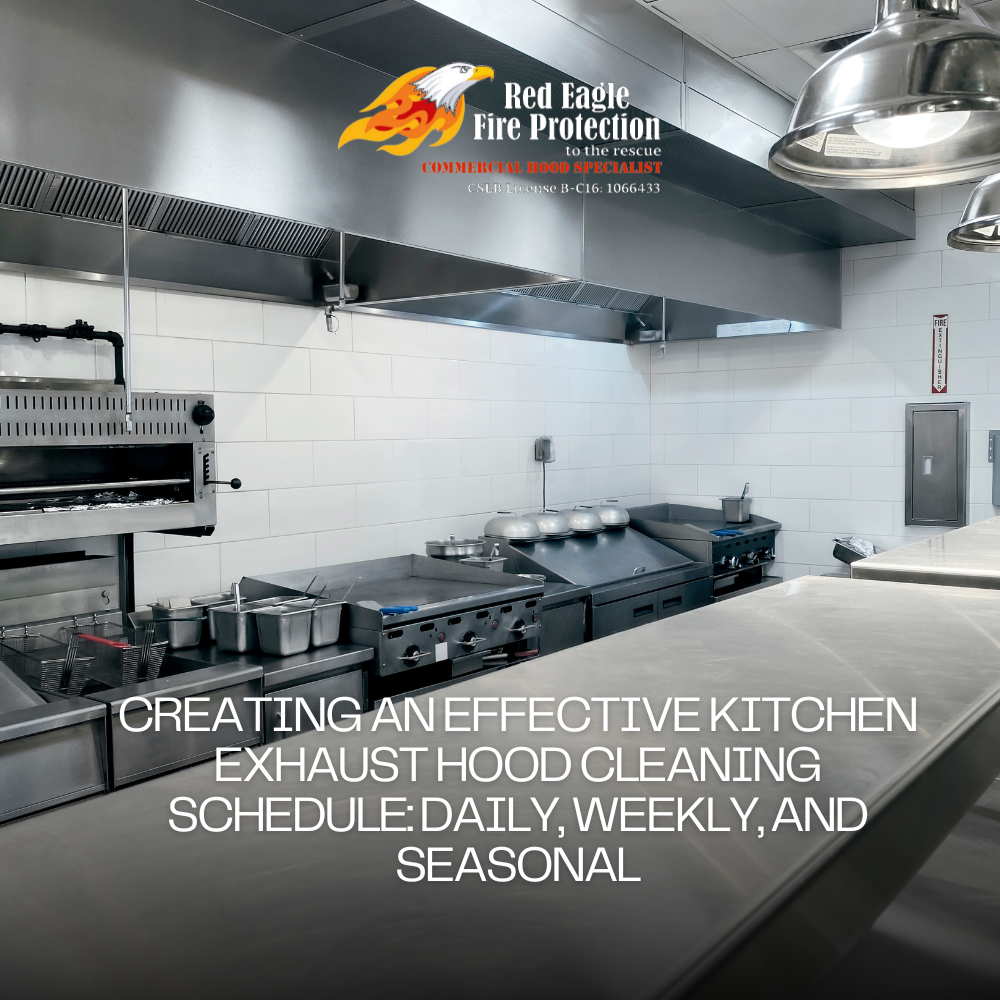Maintaining a clean and efficient kitchen exhaust hood is essential for any commercial kitchen. A well-structured cleaning schedule ensures that your exhaust system operates effectively, reduces fire risks, and complies with health and safety regulations. Here, we outline a comprehensive cleaning schedule that includes daily, weekly, and seasonal tasks to keep your kitchen exhaust hood in top condition.
Daily Cleaning Tasks
1. Wipe Down Exterior Surfaces At the end of each day, use a degreasing solution and a soft cloth to wipe down the exterior surfaces of the kitchen hood. This removes any grease splatters and prevents buildup that can harden and become more difficult to clean over time.
2. Clean Grease Filters Grease filters capture airborne grease and need daily attention. Remove the filters and soak them in hot, soapy water. Use a brush to scrub away any remaining grease, then rinse thoroughly and allow them to dry before reinstalling. Some filters can be cleaned in a commercial dishwasher if specified by the manufacturer.
3. Check and Clean Drip Trays Drip trays collect grease that drips from the filters. Empty and clean these trays daily to prevent overflow and reduce fire risk. Use a degreasing solution and a cloth or brush to scrub away any grease residue.
4. Inspect Fan and Motor Area Ensure that the fan and motor areas are free from grease and debris. While this area doesn’t typically require daily cleaning, a quick inspection can help identify any issues early on. If grease is present, wipe it down with a degreaser.
5. Clean Hood Interior The interior surfaces of the kitchen hood should be wiped down daily to remove grease buildup. Use a non-abrasive cloth and a degreasing solution to clean the interior, paying particular attention to corners and edges where grease can accumulate.
Weekly Cleaning Tasks
1. Disassemble and Clean Filters Even with kitchen exhaust hood cleaning, grease filters can accumulate residue that requires more thorough cleaning. Remove the filters and soak them in a solution of hot water and a commercial-grade degreaser. Use a brush to scrub away any stubborn grease deposits, rinse them thoroughly, and let them dry completely before reinstalling.
2. Clean the Exhaust Hood Interior and Exterior While daily wiping of the hood’s exterior and interior is essential, a weekly deep clean involves using a stronger degreasing solution. Spray the degreaser on all surfaces, allowing it to sit for a few minutes to break down grease. Use a non-abrasive scrub brush or cloth to scrub all surfaces, paying extra attention to corners and crevices where grease can accumulate.
3. Inspect and Clean the Fan and Motor The fan and motor are critical components of the exhaust system and can accumulate grease over time. Turn off and unplug the hood before cleaning these parts. Use a degreasing spray and a soft brush to clean the fan blades and motor housing. Ensure that all components are dry before plugging the hood back in and turning it on.
4. Check and Clean the Ductwork Grease can build up inside the ductwork, reducing the efficiency of the exhaust system and posing a fire hazard. While professional cleaning of the entire duct system is recommended periodically, you can clean accessible parts of the ductwork weekly. Use a long brush to remove grease and debris from the ducts near the hood.
5. Clean and Empty Drip Trays Drip trays collect grease that drips from the filters and should be emptied and cleaned daily. For weekly deep cleaning, soak the trays in hot, soapy water and scrub them thoroughly with a brush to remove any residual grease. Rinse and dry them before placing them back in the hood.
6. Polish Stainless Steel Surfaces After cleaning, polish stainless steel surfaces to maintain their appearance and prevent future grease buildup. Use a stainless steel cleaner and a soft cloth, wiping in the direction of the grain for the best results.
Seasonal Cleaning Tasks
1. Deep Clean the Ductwork Spring is an excellent time to perform a thorough cleaning of the ductwork. Grease and debris can build up over time, reducing airflow efficiency and increasing fire risk. Schedule a professional duct cleaning service to ensure that the entire system is free from obstructions and buildup.
2. Inspect and Replace Filters Spring is also a good time to inspect the condition of your grease filters. Replace any worn or damaged filters to ensure optimal performance. Clean reusable filters thoroughly by soaking them in a degreasing solution and scrubbing away any accumulated grease.
3. Test the Exhaust Fan and Motor Ensure that the exhaust fan and motor are operating efficiently. Listen for any unusual noises that might indicate wear or damage. Lubricate the motor bearings if necessary and check for any loose connections or parts that might need tightening or replacement.
4. Check for Signs of Wear and Tear The summer months can be particularly demanding on commercial kitchens due to higher volumes of customers. Inspect the entire exhaust hood system for signs of wear and tear, including cracks, rust, and other damage. Address any issues promptly to prevent them from becoming more serious problems.
5. Clean Exterior Surfaces High temperatures and humidity can contribute to grease and grime buildup on exterior surfaces. Use a commercial-grade degreaser to clean all accessible surfaces of the exhaust hood, including the exterior and any surrounding cabinetry or walls.
6. Monitor Airflow Efficiency Ensure that the exhaust system maintains optimal airflow. Reduced airflow can indicate blockages or inefficiencies within the system. Test the airflow and address any issues to maintain proper ventilation and kitchen safety.
7. Evaluate Fire Suppression System Check the fire suppression system integrated with your exhaust hood to ensure it is in good working order. Replace any expired fire suppressant canisters and test the system to ensure it activates correctly in the event of a fire.
8. Prepare for Increased Winter Usage With the approach of the holiday season, many commercial kitchens experience increased usage. Ensure that your exhaust hood system is prepared for higher volumes of cooking by conducting a thorough maintenance check. Replace any components showing signs of wear and ensure that the system operates efficiently.
9. Perform a Comprehensive Inspection Winter is an ideal time to perform a comprehensive inspection of the entire exhaust hood system. Check all components, including the fan, motor, ductwork, and filters, for any signs of damage or wear. Address any issues immediately to prevent breakdowns during the busy holiday season.
10. Clean and Polish Stainless Steel Surfaces Winter maintenance should include a thorough cleaning and polishing of all stainless steel surfaces. Use a stainless steel cleaner and a soft cloth to remove fingerprints, smudges, and grease buildup, leaving your exhaust hood looking pristine.
11. Schedule Professional Maintenance Consider scheduling a professional maintenance service to perform a detailed inspection and cleaning of your exhaust hood system. Professionals can identify and address issues that may not be apparent during routine cleanings, ensuring that your system operates at peak efficiency.
Best Practices for Effective Cleaning
1. Keep a Maintenance Log Maintain a detailed log of all maintenance activities, including the date, tasks performed, and any issues identified. This documentation helps track the condition of your exhaust hood system and ensures that all necessary maintenance tasks are completed on schedule.
2. Train Staff on Maintenance Procedures Ensure that all kitchen staff are trained on proper maintenance procedures and understand the importance of regular cleaning and inspections. Assign specific tasks to team members to ensure consistency and accountability.
3. Follow Manufacturer Guidelines Adhere to the manufacturer’s maintenance guidelines for your specific exhaust hood model. This ensures that you use the correct cleaning methods and products and that your system remains under warranty.
4. Prioritize Safety Always prioritize safety during maintenance activities. Use appropriate personal protective equipment (PPE), such as gloves and eye protection, when handling cleaning chemicals and performing maintenance tasks.
By implementing a structured cleaning schedule that includes daily, weekly, and seasonal tasks, you can ensure that your kitchen exhaust hood cleaning remains in top condition year-round. This proactive approach promotes a safe, efficient, and compliant kitchen environment, ultimately benefiting both staff and customers.
READ MORE:
Seasonal Maintenance: Keeping Your Commercial Kitchen Exhaust Hood in Top Condition Year-Round

